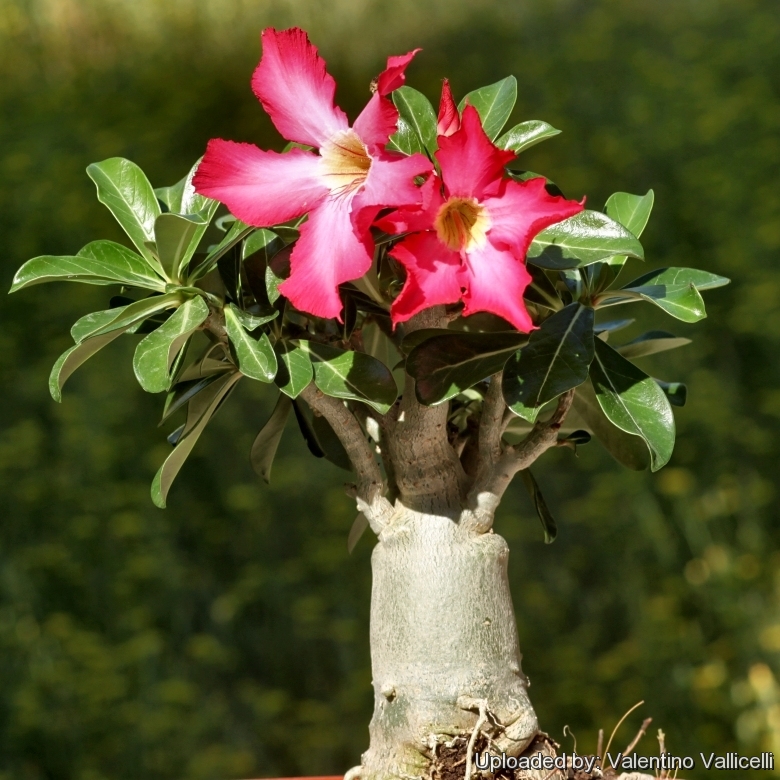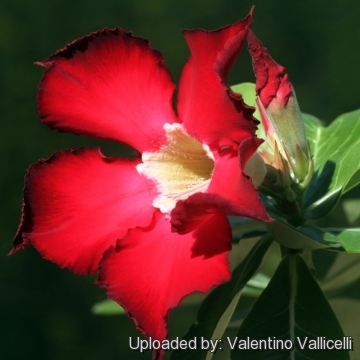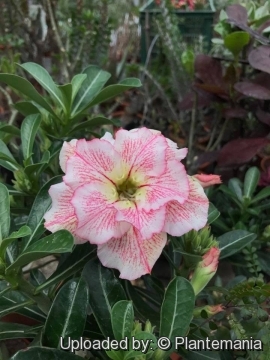
Adenium obesum hybrid Photo by: Valentino Vallicelli
Origin and Habitat: Garden origin (Nursery produced cultivar). These hybrid has been developed especially in USA, Thailand, Taiwan and India. In Asia breeding and selection efforts were probably most intense in Thailand.
Synonyms:
See all synonyms of Adenium obesum
Description: Adeniums have many spectacular hybrids and elite clones. The huge number of hybrids occurs in a wide range of flower colours, with variable patterns, shape and sizes that start blooming in the spring when the conditions are warm and days get longer, and continue blooming through the fall and winter in warmer climates. Several "species" are involved in the breeding: Adenium obesumSN|116]], Adenium somalenseSN|128]], Adenium somalenseSN|110]]SN|128]] var. crispum and Adenium swazicumSN|128]]SN|110]]. Pure white clones, red frilled clones and variegates are also cultivated and propagated. Adenium somalenseSN|128]]hybrid|SN|25614]]s can be multi-grafted with several colours on the same plant. The numerous hybrids are propagated mainly by grafting on to seedling rootstock. The swollen base will be usually formed only when the stock plant is grown from seed.
Habit: Adenium obesumSN|116]]hybrid|SN|25614]]s are pachycaul succulent shrub or small tree with a stout, swollen basal caudex forming an opened crown becoming denser with age. They are evergreen or drought-deciduous, but can also lose their leaves during cold spells. They are quite variable in habit. Current selections tend to favour the compactness of hybrids and the discovery of genetic dwarf lines of Adeniums obesum may lead to ultra compact hybrids.
Stem: 2–4 m tall, but usually much smaller, fleshy, with a distinct irregular swollen base, or caudex up to 1 (-2) m in diameter, much of which is underground. Above ground the caudex can be globose to conical with smooth, pale greyish-green to brown bark. In mature specimens a definite caudex may no longer be recognizable as the it forms a swollen trunk with few irregularly thickened branches. The branches are smooth, greyish-green, pubescent at apex and usually upright, tortuous and irregularly spaced but sometime they are weak and spreading. The plant contains a copious sticky watery or white sap that flows from broken stem as well as from other plant parts like leaves, roots etc.
Roots: Fleshy taproot.
Leaves: Spirally arranged, clustered toward the tips of the shoots, scentless, simple entire, spathulate to obovate, fleshy, leathery in texture, hairless, shiny dark green to bluish-green above, paler green and dull below, 5–12 cm long and 1–6 cm broad. The apex is rounded and the base tapers into a very short petiole usually less than 2 mm long.
Flowers: Bisexual, regular, very showy and arranged in - more or less - dense, cymes that stay above the leaves, tubular with flared lips 2–5 cm long, with the outer portion 4–8 (or more) cm diameter with five petals and wavy or crinkled margins. The flowers range from dark bloody-red, through pink to white, often with a whitish blush outward of the throat, bicoloured flowers are also frequent. Sepals oval 6-12 mm long, pedicel 5-9 mm long. Ademiums are usually monoecious and self-sterile.
Blooming time: It is capable of flowering all year, even sparingly during the winter, but it is more floriferous during the dry periods of Spring and Autumn. Flowers appear often before leaves on deciduous branches, and for a time the crown is adorned only with flowers as new leaves emerge below the flowers. The flowers opening for 2-3 days.
Fruit: The fruit is a twin follicle about 10-22 cm long resembling the horns of a steer. The two follicles are united at the base, narrowly oblong, slightly recurved, pale grey-green to grey-brown, and tapering at both ends. When matured, the follicles dehisce (split) along one side to release the seeds.
Seeds: Long narrow cylindric, 10-14 mm long, brown slightly scabrid, with long silky dirty-white to golden-brown hairy tufts at both ends.
(pappus) at each end so that the seed is blown along the ground like an axle with two wheels.
Chromosome number: 2n = 22
 Adenium obesum hybrid Photo by: Valentino Vallicelli
Adenium obesum hybrid Photo by: Valentino Vallicelli Adenium obesum hybrid Photo by: © Plantemania
Adenium obesum hybrid Photo by: © PlantemaniaCultivation and Propagation: Originally from arid to semi-arid regions, Adeniums are nonetheless frequently cultivated in humid tropical or semi-tropical areas. They are nearly evergreen if grown in a warm greenhouse or tropical conditions a and watered, but can loose their leaves and forced into a long winter dormancy in cooler climate. New growth begins early in spring. Outdoors they thrives on a xeric watering regime as required by cacti. Under ideal conditions, they can live for hundreds of years.
Pots and soils: They like pots with generous drain holes on sides and bottom, need a very porous potting medium media (add pumice, vulcanite, perlite, sand or brick chips into regular soil, or a cactus mix) seeing that the main trunk is planted with the majority of the roots below the caudex line. Its rare that adeniums will use the upper third of their soil and often this area serves like a mulch or support for the stem. Avoid choosing a very deep pot as this might encourage an oblong (carrot-shaped) underground caudex. Outdoors they adapt to a wide range drained soils.
Fertilization: To make plants develop a large swollen base/trunk and to increase flowering, they require a fertilizer rich in potassium, phosphorus and micronutrient without a too high nitrogen content. Fertilize regularly while the plant is growing.
Exposition: Bright filtered light is best but in areas where light is not as burning, plants may be kept outdoors in full sun unprotected but remember that caudex is very susceptible to sun scalding. Plant becomes leggy in the shade and its flowering reduced.
Water: Water plants preferably in the early mornings until the soil is well wetted and let excess water drains from the pot base. Watering can be done as they become drier during active growth season. Never allow plants to dry out too often as this causes them to go into early dormancy. Many plants simply never get enough water to grow and flower adequately so keep them active and growing by providing them with all the essential necessities. Water sparingly during winter months.
Drought Tolerance: High.
Hardiness: They are frost sensitive and cannot endure freezing temperatures (U.S.D.A. Zone: 10a-12). If temperatures regularly fall below 2° C, the plants should be grown in a container for moving into a cold protected area. Partial defoliation may also occur at other times in response to weather change. As an indoor plant ensures a minimum temperature in winter of 10 °C. Where year-round temperature is sufficiently warm, desert rose will not become dormant and deciduous and may be ever-blooming.
Salt Tolerance: Medium.
Maintenance: They should be re-potted frequently until they attain their desired size. Plant appearance varies from plant to plant so prune accordingly. Pruning above the leaves is more likely to produce multiple branching than pruning further down on the plant on bare stem. Pinching or pruning should be done once a year during the growing season. Pruning during winter often fails to generate robust branching.
Uses: Specimen plant; patio; flowering container plant; Bonsai, rock gardens, pool side.
Bonsai: Adenium hybryd are suitable for most bonsai styles, they are relatively fast grower: a plant can develop into a rewarding bonsai in as little as ?ve years. Many specimens develop interesting large, twisted bases and roots. Branches can be wired and growing tips pruned or pinched to encourage branching and compact. Keeping a plant root-bound is one method of achieving a bonsai plant. After the first 3 year’s of the plant’s life, raise the plant at each re-potting, exposing more and more of the underground caudex and roots.
Pests & diseases: Occasional aphids, mealybugs, scales and leaf spots. It is especially susceptible to spider mite infestation.
Warning: All parts of Desert Rose are potentially very poisonous and should be kept out of reach of children and animals. It must be handled with care. avoiding direct contact by always using gloves or covering your hands with plastic bags when handling it.
Propagation: Seed, grafting or cuttings. The numerous hybrids are propagated mainly by grafting on to seedling rootstock. While plants grown from seed are more likely to have the swollen caudex at a young age, with time many cutting-grown plants cannot be distinguished from seedlings. Propagation by cutting is also possible, cut end shoots and let dry for a day or two. Be careful of the toxic sap. Stick shoots into a pot of moist soil, and provide bottom heat. Keep soil moist. The best time for either method is in the spring.













